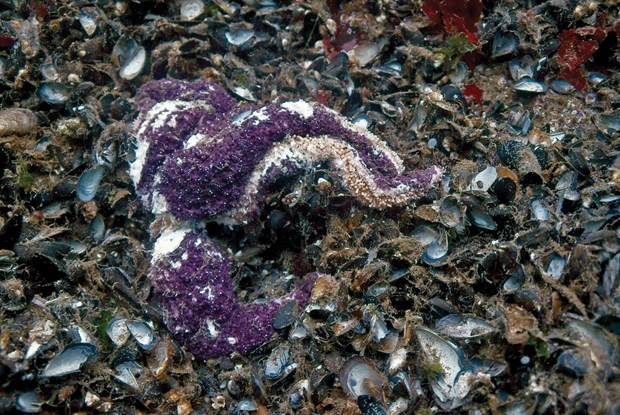West Vancouver’s Whytecliff Park is a popular playground for divers, renowned for marine scenery ranging from cloud sponges to the occasional octopus, but these days there’s something missing: sea stars.
The once-abundant sea stars that populated the seafloor and tidal zones have been decimated by a mysterious disease over the past three years.
“You would see some sea stars but you wouldn’t see the ones that used to be there three years ago, in particular sunflower stars, those are the ones that have been really affected,” said Dr. Martin Haulena, head veterinarian at Vancouver Aquarium.
In 2013, recreational divers and the aquarium’s Howe Sound Research and Conservation team began to notice sick and dying sea stars in the Strait of Georgia.
The mass die-off, which is affecting starfish along the entire West Coast, from B.C. to California, remains a mystery.
According to aquarium researchers it “may be a pathogen that affects several species in the same way, or there may be multiple agents at play. The underlying causes of the epidemic are not known.”
Scientists have dubbed it Sea Star Wasting Syndrome. In just days a healthy starfish can become deflated looking and start to lose limbs and eventually die as its body walls rupture. SSWS is decimating a number of local species, including purple stars, pink stars, mottled stars and sunflower stars.
To solve the this unprecedented “mass mortality,” universities, aquariums, researchers and the public are collaborating to better understand the epidemic.
In January, the Seattle Aquarium hosted a sea star wasting summit and Haulena was one of the experts in attendance.
Haulena said Vancouver Aquarium researchers continue to monitor and study what sea star species are affected and how they are affected. “Some species are coming back a bit and some are not. Some of the species that were very affected are not coming back to the extent that we would have thought them to come back.”
He said researchers are also collecting tissue samples to share with a variety of researchers around North America, including Cornell University, the Wildlife Conservation Centre in New York, University of California Davis and pathologists in Washington State and B.C.
Haulena said he’s heard many theories about the die-off, from global warming to radioactive fallout from Fukushima.
“There are people who want blame sewage coming out of Victoria. There’s people that want to blame industry, there’s people that want to blame.”
Haulena says it’s probably going to end up being a natural, cyclical kind of event, or something where the blame will be shared. “Whether it’s increasing acidity of the ocean, decreasing nutrient levels, increasing other nutrient levels, increasing some kind of skew, weather patterns, that kind of thing, those things probably play a role,” he said. “Or it could be a toxin, so there’s a lot of lot investigation that needs to go through.”
Haulena said he’s heard from many who feel a determined need to find a culprit, which has left him encouraged that so many people are passionate about solving the starfish riddle.
“Maybe 20 years ago I don’t think a lot of people would have cared if sea stars were dying everywhere. Now we’ve got a lot of people who really care about the environment, they care about walking on the beaches, they care about the animals that live there and not just the charismatic animals that live there, they care about sea stars, which is great.”
Some reports suggest that more than 40 species of starfish have been impacted by the disease.
“Every species has evolved over a long, long period of time, to serve a vital function – and if you take a whole species out of the equation that has major ramifications up and down the food chain. There are many species of sea stars affected.”



